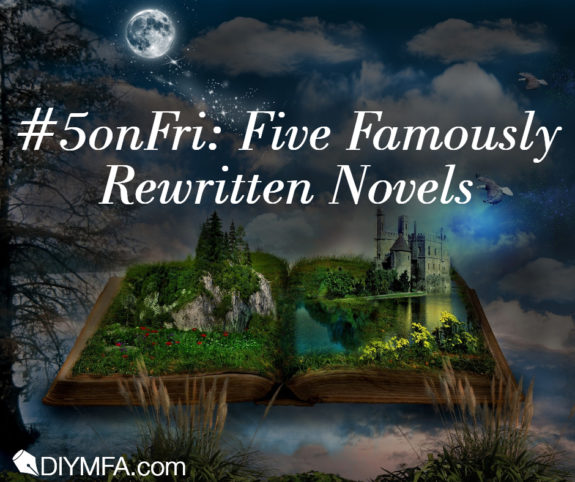Editing is a natural and necessary part of the writing process. But many writers dread revising their work. They’re exhausted from writing the first draft and the thought of changing or deleting words terrifies them. Bestselling books don’t get that way by accident. Rounds of careful revisions are what makes writing shine. Take a page from these five authors who enjoyed the editing process so much, they continued revising even after the book was published.
1) The Exorcist
The Exorcist was originally published in 1971. To celebrate its fortieth anniversary in 2011, Harper Collins ran a new print—with edits from the author, of course. Not one to settle for good enough, William Peter Blatty gave the book what he described as an “all-around polish of the dialogue and prose.”
While writing the first draft, Blatty spent a year editing and revising his characters, plot, and theme. However, his financial situation and other commitments barred him from completing a polished final draft before sending the book to his publisher. Given the opportunity later in life, Blatty jumped at the chance to finish his work. Be more like Blatty and get excited about your line editing.
2) The Hobbit
Sometimes you begin the editing process with your characters and then move to your plot. Other times a plot change can necessitate going back to edit a character. When The Lord of the Rings grew into a multi-book saga, JRR Tolkien revisited his earlier stories to match them to the world of his freshly created works. The Hobbit, the first of his novels set in Middle Earth, required some extra tweaking.
In the original “Riddles in the Dark” chapter, Gollum offers Bilbo a present—the ring—if he can answer a series of riddles. However, The Lord of the Rings trilogy painted the ring with an ability to turn the possessor mad with greed for its power. Gollum would never give up such an item willingly. Tolkien later rewrote and republished the book to reflect this. Tolkien used editing strategically to keep his world building intact.
3) Against the Fall of Night /The City and the Stars
Perhaps one of the most extreme examples of the uncontrolled impulse to edit comes from Arthur C. Clarke. In 1948, he penned a novella which, in 1953, became a full-length novel. Three years after that, it was expanded and revised again into a completely different book published under a different title. The two resulting works, Against the Fall of Night and The City and the Stars, are similar enough that one person, having read one book, might have an intelligent conversation about it with another person having read the other. Yet, the rewrite was not a superficial-level revision.
In The City and the Stars, Clarke expands on his world and his characters, deepening the theme and ideas of the story as a whole. The novel was Clarke’s way of showing his readers what he had learned, both about the world he had created and about the craft of writing. Clarke leaves us with a timeless example of how knowledge can add to the fun of editing.
4) Trimalchio
You may be better acquainted with the revised edition of this novel—The Great Gatsby. F Scott Fitzgerald’s revisions are the epitome of an 11th-hour change of heart. The original draft, called Trimalchio, was at the printers who had set the type into a galley proof (the trays which held the printing type together). Although the galleys were sent to Fitzgerald for final proofreading, he decided instead to rewrite the novel and reset the galleys.
The story underwent heavy revisions to the plot, setting, and characters—resulting in an altogether different novel. In the introduction to the Random House Trimalchio published in 2000, they explain that the “characterization is different, the narrative voice of Nick Carraway is altered and, most importantly, the revelation of Jay Gatsby’s past is handled in a wholly different way.” The lesson to be learned here? Editing doesn’t have to be finished, even when it’s set in type.
5) Frankenstein
The classic horror novel Frankenstein was published anonymously in 1818 and then reprinted in 1823 under Mary Shelley’s name. However, the Frankenstein you probably know is a version rewritten and published in 1831. The changes in Shelley’s life during these years heavily impacted the theme of the novel. Shelley had lost her daughter, son, and husband, and was in dire financial straits. In her letters, she described destiny as a weight pressing down on her, enslaving her.
Shelley’s loss of control over her own life reflected deeply in the changes made to Victor Frankenstein’s character. In the 1818 version, Dr. Frankenstein retained a capacity for good and a certain control over his actions and whether to pursue his experiments. The 1831 version leaves him caged to his fate by forces outside of his control. Shelley’s revisions show us how our emotions and life experiences can shape the editing process.
Don’t be scared of the red pen. Instead, embrace editing in all its forms. From the bottom of the revision pyramid to the very top, your writing will shine when you revise, rework, and (in these authors’ cases) republish.

Jeanette the Writer is an editor, coach, and freelance writer who wants to help others demolish their editing fears and finish their manuscript. As a former scuba instructor turned entrepreneur, Jeanette knows about putting in the hard work to pursue your passions. She has worked with authors, speakers, coaches, and entrepreneurs—empowering them with the right mindset, knowledge, and tools to help them tackle their editing goals. You can learn more about Jeanette by visiting JeanetteTheWriter.com.







